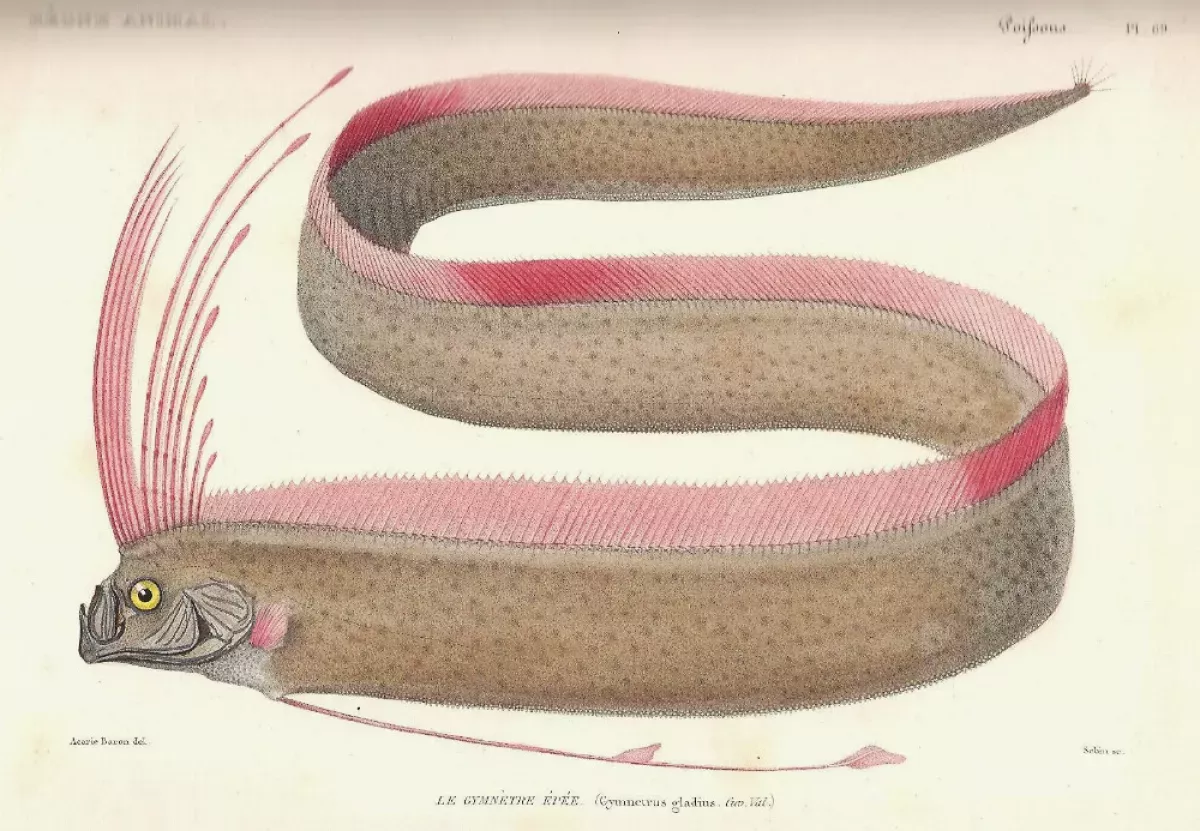Oarfish are a family (Regalecidae) of large, elongated fish found in temperate and tropical oceans. They are rarely observed, making them a subject of fascination. The giant oarfish, one of the three species within this family, is the longest bony fish alive, reaching lengths of up to 8 meters (26 feet).
2001: Oarfish Filmed Alive by U.S. Navy
In 2001, a 1.5-meter (4.9-foot) oarfish was filmed alive by U.S. Navy personnel during a buoy inspection in the Bahamas. The oarfish propelled itself using an amiiform mode of swimming and was observed swimming in a vertical orientation, potentially indicating a feeding posture.
February 2003: Oarfish Caught in the UK
An oarfish measuring 3.3 meters (11 feet) and weighing 63.5 kilograms (140 pounds) was caught using a fishing rod baited with squid at Skinningrove, United Kingdom in February 2003.
July 2008: First Confirmed Sighting of Oarfish in Natural Habitat
In July 2008, scientists captured footage of an oarfish swimming in the mesopelagic zone in the Gulf of Mexico. This was the first confirmed sighting of an oarfish at depth, with the fish estimated to be between five and ten meters (16 and 33 feet) in length.
2008: Oarfish Observations in the Gulf of Mexico
As part of the SERPENT Project, five observations of healthy oarfish were reported from the northern Gulf of Mexico between 2008 and 2011 at depths within the epipelagic and mesopelagic zones.
December 2009: Unusual Oarfish Appearances in Japan
From December 2009 to March 2010, unusual numbers of slender oarfish appeared in the waters and on the beaches of Japan. These appearances are said to portend earthquakes, building up the myth after the 2011 Tōhoku earthquake and tsunami.
March 2010: Unusual Oarfish Appearances in Japan
From December 2009 to March 2010, unusual numbers of slender oarfish appeared in the waters and on the beaches of Japan. These appearances are said to portend earthquakes, building up the myth after the 2011 Tōhoku earthquake and tsunami.
2011: Oarfish Myth and 2011 Tōhoku Earthquake
After the 2011 Tōhoku earthquake and tsunami, which killed over 20,000 people, many pointed to the unusual oarfish appearances from 2009-2010 to support the myth of the oarfish as a harbinger of earthquakes.
2011: Deepest Verified Record of Oarfish
In 2011, an oarfish was observed switching from a vertical to lateral swimming posture in the northern Gulf of Mexico, at a depth of 463–492 meters (1,519–1,614 feet), marking the deepest verified record of R. glesne.
2016: Jeremy Wade's Oarfish Encounter
In 2016, Animal Planet aired an episode of River Monsters featuring Jeremy Wade's encounter with live oarfish while diving. Wade filmed two oarfish as they ascended to the surface, even touching one of them.
January 2019: Live Oarfish Found in Okinawa
In January 2019, two live oarfish were found in the nets of fishermen on the Japanese island of Okinawa.
February 2019: First Successful Artificial Insemination of Oarfish
From January to February 2019, researchers achieved the first successful artificial insemination and hatching of the oarfish using gonads from washed-up specimens. The larvae swam using their pectoral fins and died of starvation after four days.
Mentioned in this timeline
Japan is an East Asian island country situated in the...

An earthquake is the shaking of the Earth's surface caused...

A tsunami is a series of powerful waves caused by...
Mexico officially the United Mexican States is a North American...

The Gulf of Mexico is a marginal sea of the...
The foot is a crucial anatomical structure present in numerous...
Trending

1 month ago NFL Week 12 Predictions: Colts vs. Chiefs, Cowboys, and potential season-shaping games.

6 months ago Dwayne Johnson's WWE feuds, scene-stealing cameo, and streaming success in Moana 2.

2 months ago Jonas Brothers Celebrate Holiday Season with New Christmas Movie and Soundtrack

6 months ago Shannon Sharpe Lawsuit: Settlement Reached, Case Dismissed with Prejudice Amidst Courtroom Drama.

1 month ago Jeff Bezos envisions millions leaving Earth for space; Blue Origin rivals SpaceX.

7 months ago Jennifer Garner and John Miller share passionate kiss; Ben Affleck spotted solo.
Popular

Stranger Things created by the Duffer Brothers is a popular...

XXXTentacion born Jahseh Dwayne Ricardo Onfroy was a controversial yet...
Turning Point USA TPUSA is an American nonprofit organization founded...

Candace Owens is an American conservative political commentator and author...

Bernie Sanders is a prominent American politician currently serving as...

Melania Trump a Slovenian-American former model has served as First...
